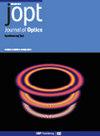Highly coherent mid-infrared wideband supercontinuum generation by a silica cladded silicon nitride core buried waveguide
IF 2.7
4区 物理与天体物理
Q3 OPTICS
引用次数: 0
Abstract
Optical waveguides with semiconductor cores are drawing considerable research interest in the domain of supercontinuum (SC) generation in recent times. In this work, we design a square-core silicon nitride buried waveguide with a silica-clad, aiming for a wideband spectrum generation in the mid-IR region when operated at the standard telecommunication wavelength of 1550 nm. Among different such silicon nitride square-core buried waveguides, we propose a typical design with dimensions of 400 nm × 400 nm along its height and width, capable of producing a highly coherent broadband intensity spectrum ranging from 810 nm to 5441 nm after propagating through just a few millimeters of the waveguide. The group velocity dispersion maintains minimal value over a broad wavelength range in the mid-IR region, while the nonlinear coefficient is estimated to be sufficiently high. The nonlinear pulse propagation through such a waveguide leads to achieving an SC spanning over 2.76 octaves, sufficiently broader than previously reported silicon nitride-based waveguides. Furthermore, our calculations confirm the highly coherent nature of the generated SC. To the best of our knowledge, this is the first report of SC generation maintaining a high degree of coherence over such a wide wavelength range in the mid-IR zone using a square-core silicon nitride buried waveguide.通过硅包覆氮化硅芯埋入式波导产生高相干中红外宽带超连续真空
带半导体芯的光波导近来在超连续(SC)产生领域引起了相当大的研究兴趣。在这项工作中,我们设计了一种带有二氧化硅包层的方形氮化硅芯埋入式波导,目的是在标准电信波长 1550 nm 下工作时产生中红外区域的宽带光谱。在不同的此类氮化硅方芯埋入式波导中,我们提出了一种典型的设计,其高度和宽度尺寸均为 400 nm × 400 nm,在波导中传播几毫米后就能产生从 810 nm 到 5441 nm 的高度相干宽带强度光谱。在中红外区域的宽波长范围内,群速度色散保持最小值,而非线性系数估计足够高。非线性脉冲在这种波导中的传播导致实现了跨度超过 2.76 个倍频程的 SC,比之前报道的氮化硅基波导宽得多。此外,我们的计算还证实了所产生的 SC 的高度相干性。据我们所知,这是首次报道使用方形氮化硅芯埋入式波导在中红外区如此宽的波长范围内产生保持高度相干性的 SC。
本文章由计算机程序翻译,如有差异,请以英文原文为准。
求助全文
约1分钟内获得全文
求助全文
来源期刊

Journal of Optics
OPTICS-
CiteScore
4.50
自引率
4.80%
发文量
237
审稿时长
1.9 months
期刊介绍:
Journal of Optics publishes new experimental and theoretical research across all areas of pure and applied optics, both modern and classical. Research areas are categorised as:
Nanophotonics and plasmonics
Metamaterials and structured photonic materials
Quantum photonics
Biophotonics
Light-matter interactions
Nonlinear and ultrafast optics
Propagation, diffraction and scattering
Optical communication
Integrated optics
Photovoltaics and energy harvesting
We discourage incremental advances, purely numerical simulations without any validation, or research without a strong optics advance, e.g. computer algorithms applied to optical and imaging processes, equipment designs or material fabrication.
 求助内容:
求助内容: 应助结果提醒方式:
应助结果提醒方式:


